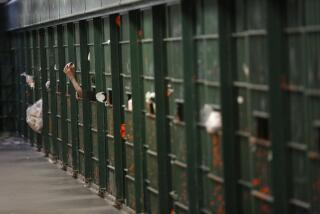Even violent and sex offenders released early by L.A. County Jail
- Share via
More jail inmates in Los Angeles County are being set free after serving only a fraction of their sentences because of budget problems and a space crunch caused by an influx of offenders now serving their terms in county jails rather than state prisons.
The releases are benefiting even inmates sentenced to jail for violence and sex crimes, with those offenders released after serving as little as 40% of the time they were meant to spend behind bars, according to Sheriff’s Department records obtained by The Times under the California Public Records Act.
Other criminals are serving even shorter stints. Under the department’s current policy, jailers immediately release male inmates sentenced to less than 90 days and female offenders sentenced to less than 240 days.
So far this year, the Sheriff’s Department has released more than 23,000 inmates before their jail terms were up, a sharp increase over recent years. During all of 2012, the county released 26,000 inmates early, according to department records. In 2011, the number was about 15,700.
The early releases have raised concerns among some on the Board of Supervisors. Supervisor Gloria Molina accused Sheriff Lee Baca of cutting the time inmates serve “willy-nilly” and of failing to explain his rationale to the board. In an interview Friday, Molina said the early releases do a disservice to the victims of crime.
“Everybody wants to make sure their neighborhood is safe,” she said. “I don’t think people in the general public have any idea that [criminals] are not serving as much time as possible.”
Sheriff’s officials said they have had little choice but to free some inmates before their jail terms are complete.
A budget squeeze after the economic downturn of the late part of the last decade, they said, left the department without the money to keep open some sections of the county’s jails. Meanwhile, dramatic changes in sentencing laws have shifted the burden of housing thousands of offenders convicted in Los Angeles County from state prison to county detention facilities, putting more pressure on what was already the largest local jail system in the nation.
“Everybody here wants offenders to be accountable for their criminal behavior,” Assistant Sheriff Terri McDonald said. “There’s not enough money.... There aren’t enough resources.”
On a recent morning outside Men’s Central Jail in downtown Los Angeles, Cody Gene Johnson celebrated walking free a day after he was sentenced to 90 days in jail for violating a restraining order. Johnson had spent only 12 days in custody before his sentencing.
“I got to say, it’s a blessing that they did let me out early, but they got to watch the type of people they let out,” Johnson said.
Another inmate, who gave only his first name, Matthew, said he served about three months of an 18-month sentence for attempted robbery. He expressed mixed feelings about early release, saying jail can have a positive effect on some inmates.
“There’s some people that can change inside,” the 23-year-old said.
Releasing inmates early has been an issue since the 1980s, when a federal judge ruled that jail overcrowding amounted to cruel and unusual punishment for inmates. Freeing some inmates early was meant to be a temporary fix but has continued ever since, ebbing and flowing over the years.
During the early 2000s, budget cuts prompted Baca to start closing jail facilities, and many inmates were freed after serving only 10% of their time. A 2006 Times investigation found that nearly 16,000 inmates released early were rearrested for new offenses while they were meant to be in jail. Sixteen were charged with murder.
Better budget times in the years that followed helped the Sheriff’s Department to increase the time that male inmates served to 80%. But by 2010, the souring economy had cut into county revenues, and sheriff’s officials began releasing inmates after they had served less of their sentences.
A year later, the county started to accept inmates sent to jail as part of realignment, the controversial state law that was designed to address a federal court order to reduce California’s prison population. The change shifted the burden of housing some offenders from state prisons to county jails.
Today, Los Angeles County houses about 6,000 inmates under the program, with some sentenced to lengthy terms. The Sheriff’s Department is not releasing those inmates early. Although the county received funds from the state to house the additional inmates, it was not enough, said McDonald, the assistant sheriff.
To relieve the pressure on the jails and avoid overcrowding, sheriff’s officials release inmates serving traditional county jail sentences. That population makes up about 1,200 — or 6% — of the jail system’s roughly 18,800 inmates.
Under California law, jail inmates generally receive a day of credit for every day they serve, including any time they spend in custody before their sentencing hearings. That means that inmates serve at most half their sentences even when there is no early release. The sheriff’s early-release program applies to the time inmates are meant to serve in jail following their sentencing hearings.
The Sheriff’s Department now releases most men sentenced to more than 90 days for nonviolent offenses after they serve 20% of their remaining jail time. So a male inmate sentenced to a year in jail could end up serving little more than a month. Most nonviolent women sentenced to 240 days or more are released after serving 10%.
In February, the department cut the terms for men and women incarcerated for more serious crimes, such as assault with a deadly weapon and child molestation, from 65% to 40% of their remaining jail time, according to department figures.
Building enough jail space to fix the problem would be expensive. A firm hired by the Board of Supervisors to examine the cost of a new facility to replace the aging Men’s Central Jail said in a report last week that the Sheriff’s Department would need 3,259 more beds to keep inmates for 75% of their terms, costing the county an additional $675 million on top of the $1-billion-plus price tag already projected.
An aide to Supervisor Michael D. Antonovich said the county could adopt a cheaper solution by contracting with other counties to house L.A. County inmates. Molina said she also supports that option.
Supervisor Zev Yaroslavsky said at a recent board meeting that the county should look at whether it could reduce the jail population without seeing a surge in crime. He noted that crime rates have remained at an “all-time low” despite the early releases.
The board is expected to soon consider a contract to send more than 500 inmates with long sentences to firefighting camps supervised by state corrections officials.
McDonald said the Sheriff’s Department is examining a wide variety of possible options, including what to do with inmates awaiting trial, who make up the bulk of the jails’ population. She said other inmates nearing the end of their sentences could be sent to secure residential facilities that provide drug treatment and mental health services in an effort to target the underlying problems that land many behind bars.
The department has started a pilot project that houses about 40 women wearing GPS tracking devices in a drug treatment program, McDonald said. Expanding such programs would free up jail space, allowing the department to increase the time other offenders spend in custody, she said.
“It’s more sophisticated for the county to look at who should be in our jail beds and who should be in some other kind of program” that reduces recidivism, McDonald said.
More to Read
Sign up for Essential California
The most important California stories and recommendations in your inbox every morning.
You may occasionally receive promotional content from the Los Angeles Times.












